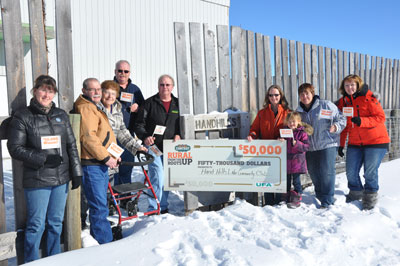
The Hand Hills Lake Club were successful in this round of UFA’s "Rural From the Roots Up" Contest. This means they will be receiving $50,000 and will be giving away the next prize to a deserving community project.
“We are pretty excited,” said Marilyn Vredegoor of the club. “We have been finalists in all four rounds.”
She explains it has been a challenge to get noticed in the contest simply because they do not show up on the map. Unlike most applications that have a well-known geographical base, the Hand Hills does not, but it still has pride.
“We are not on the map. We are in the middle of the bald prairie doing what we do, but when you ask people like Colt Cosgrave where he is from, he says the Hand Hills,” said Vredegoor.
The Hand Hills, while not a stand alone municipality, has the distinction of being the highest point between the Rockies and the Cypress Hills. It is also home to some of Alberta’s rich rodeo history. Started as a Red Cross fundraiser during World War 1, the Hand hills Lake Stampede is only a couple years shy of celebrating its centennial. The Club also hosts other events and fundraisers, and there are always rave reviews for their homemade pie.
Vredegoor says the $50,000 will go towards fixing up their kitchen. Right now the kitchen is cramped and not ideal to serve the crowd of 2,000 or so that come each year for the Stampede, or the 700 they cook for at their turkey dinner.
In fact, often barbecues are run out of horse trailers in inclement conditions.
According to Vredegoor, the main thrust of the initial renovation will be to create work space and storage. Right now, some of their freezers and equipment is stored in the hall outside the kitchen.
“Our community base has expanded over the years, and as communities around us close their doors or become inactive, we find those community-minded people are coming to the Hills. People want and need a community and that is what we offer. We are a real rural community, 40 kilometers from any town, the real deal, with a real need,” states their application for the contest.
Now that the Hand Hills Lake Club has been selected as a prize winner, it is their turn to select the next recipient of the grant. Hand hills was selected by previous winner, the Spruce View Ag Society,
“Hand Hills was a winner in our eyes because they are truly rural and the project impacts generations of people. The stampede has a deep history and their community centre supports many different groups,” said Mitch Hetu, Spruce View Agricultural Society.
The next round of finalists has not been announced.





























